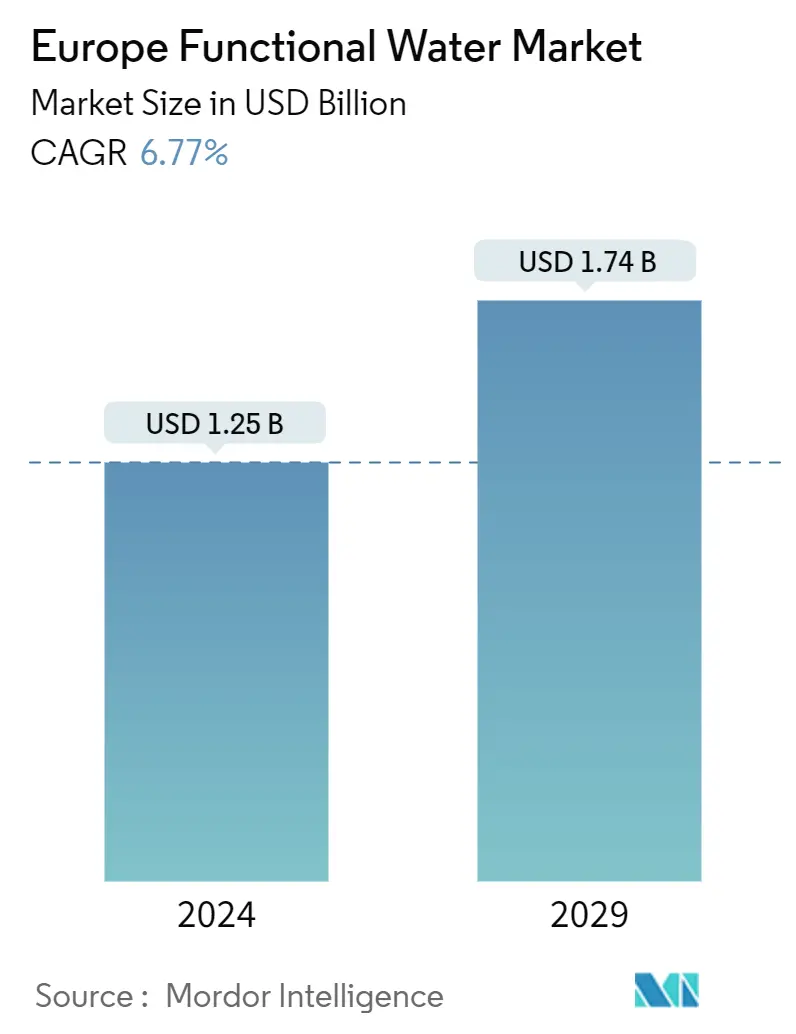Market Size of Europe Functional Water Industry

| Study Period | 2019 - 2029 |
| Base Year For Estimation | 2023 |
| Market Size (2024) | USD 1.25 Billion |
| Market Size (2029) | USD 1.74 Billion |
| CAGR (2024 - 2029) | 6.77 % |
| Market Concentration | High |
Major Players.webp)
*Disclaimer: Major Players sorted in no particular order |
Europe Functional Water Market Analysis
The Europe Functional Water Market size is estimated at USD 1.25 billion in 2024, and is expected to reach USD 1.74 billion by 2029, growing at a CAGR of 6.77% during the forecast period (2024-2029).
Functional water products usually contain vitamins, minerals, acids, and herbs, which are associated with supporting the immune system, cognitive function, and gut health. They also contain additives, known as aquaceuticals, that offer extra nutritional value. Therefore, with the growing trend toward health and wellness among consumers, functional water is gaining popularity and is increasingly being sold in global markets. Consumers' inclination toward non-alcoholic beverages leads to the consumption of functional beverages.
The demand for functional drinks is massive compared to fruit juices and carbonated beverages. Furthermore, the increasing trend of sugar-free or natural-sweetener-based functional water with fewer calories is anticipated to drive market growth during the forecast period. Moreover, the expansion of retail industries and the ease of availability of functional drinks through e-commerce, retail, and grocery stores contribute to market growth. Companies are launching products to cater to changing consumer tastes and preferences. For instance, in April 2023, Coca-Cola launched Glacéau Vitaminwater, the low-calorie drink, in Switzerland. It contains a variety of vitamins and minerals and is available in three flavors, which are "Blueberry and lavender," "Raspberry and apple," and "Citrus and guava".
Europe Functional Water Market Segmentation
Functional water is formulated using acids, herbs, raw fruits, or vegetables that provide various health advantages. It falls under the non-alcoholic beverage category.
The European functional water market has been segmented by product type, distribution channel, and geography. The market studied has been segmented by product type into flavored and plain functional water. The market studied has been segmented by distribution channel into convenience/grocery stores, hypermarkets/supermarkets, online channels, and other distribution channels. This study also involves the analyses of countries such as Germany, the United Kingdom, Italy, France, Russia, Spain, and the Rest of Europe. The market sizing and forecasts have been done for each segment based on value (USD).
| By Product Type | |
| Flavored Functional Water | |
| Plain Functional Water |
| By Distribution Channel | |
| Supermarkets/Hypermarkets | |
| Convenience/Grocery Stores | |
| Online Stores | |
| Other Distribution Channels |
| By Country | |
| United Kingdom | |
| Russia | |
| Spain | |
| France | |
| Germany | |
| Italy | |
| Rest of Europe |
Europe Functional Water Market Size Summary
The European functional water market is experiencing significant growth, driven by a rising consumer preference for health and wellness-oriented products. Functional waters, enriched with vitamins, minerals, and other beneficial additives, are becoming increasingly popular as consumers shift towards non-alcoholic beverages that offer additional nutritional value. This trend is further supported by the growing demand for sugar-free or naturally sweetened options, which cater to health-conscious individuals seeking low-calorie alternatives. The expansion of retail channels, including e-commerce and grocery stores, has made these products more accessible, contributing to their widespread adoption. Companies are actively launching new products to meet evolving consumer tastes, with strategic marketing efforts such as product positioning and promotional schemes enhancing visibility and encouraging impulse purchases.
The market is characterized by intense competition among major players, who are employing various strategies like product innovation, mergers, and partnerships to capture a larger market share. The presence of global and regional brands such as Coca-Cola, PepsiCo, Danone, and Nestle underscores the concentrated nature of the industry. These companies are not only focusing on expanding their product lines but also on catering to specific consumer needs, such as those avoiding sugary drinks due to health concerns like diabetes. The increasing health consciousness among consumers, coupled with the convenience of functional waters as a dietary supplement, is propelling market growth across Europe.
Europe Functional Water Market Size - Table of Contents
-
1. MARKET DYNAMICS
-
1.1 Market Drivers
-
1.1.1 Demand for Healthy Hydration Products
-
1.1.2 Advertisement and Promotional Activities Gaining Prominence
-
-
1.2 Market Restraints
-
1.2.1 Inclination Toward Other Functional Beverages
-
1.2.2 High Cost Associated with Functional Water
-
-
1.3 Porter's Five Forces Analysis
-
1.3.1 Threat of New Entrants
-
1.3.2 Bargaining Power of Buyers/Consumers
-
1.3.3 Bargaining Power of Suppliers
-
1.3.4 Threat of Substitute Products
-
1.3.5 Intensity of Competitive Rivalry
-
-
-
2. MARKET SEGMENTATION
-
2.1 By Product Type
-
2.1.1 Flavored Functional Water
-
2.1.2 Plain Functional Water
-
-
2.2 By Distribution Channel
-
2.2.1 Supermarkets/Hypermarkets
-
2.2.2 Convenience/Grocery Stores
-
2.2.3 Online Stores
-
2.2.4 Other Distribution Channels
-
-
2.3 By Country
-
2.3.1 United Kingdom
-
2.3.2 Russia
-
2.3.3 Spain
-
2.3.4 France
-
2.3.5 Germany
-
2.3.6 Italy
-
2.3.7 Rest of Europe
-
-
Europe Functional Water Market Size FAQs
How big is the Europe Functional Water Market?
The Europe Functional Water Market size is expected to reach USD 1.25 billion in 2024 and grow at a CAGR of 6.77% to reach USD 1.74 billion by 2029.
What is the current Europe Functional Water Market size?
In 2024, the Europe Functional Water Market size is expected to reach USD 1.25 billion.

